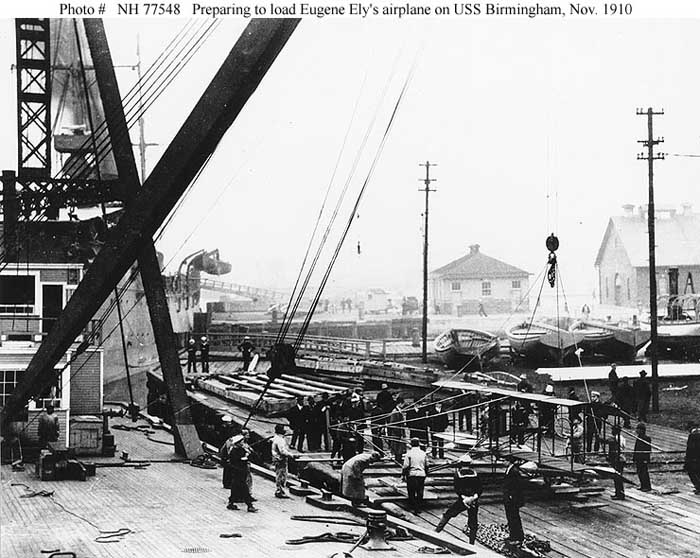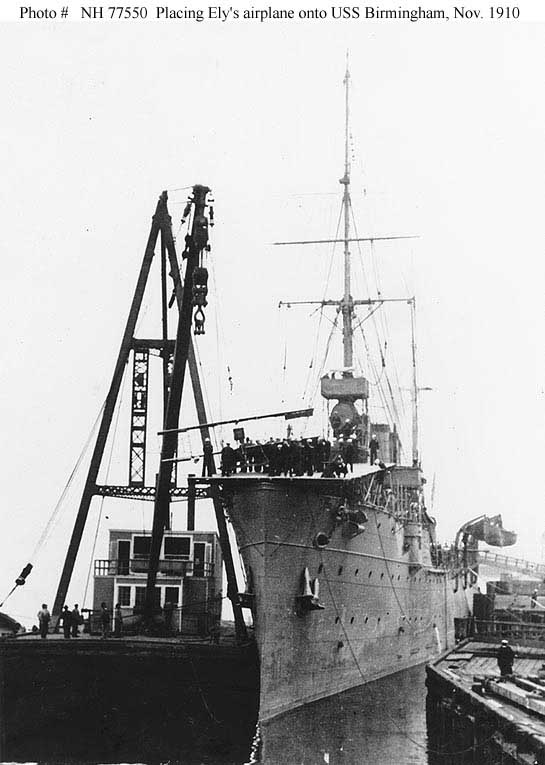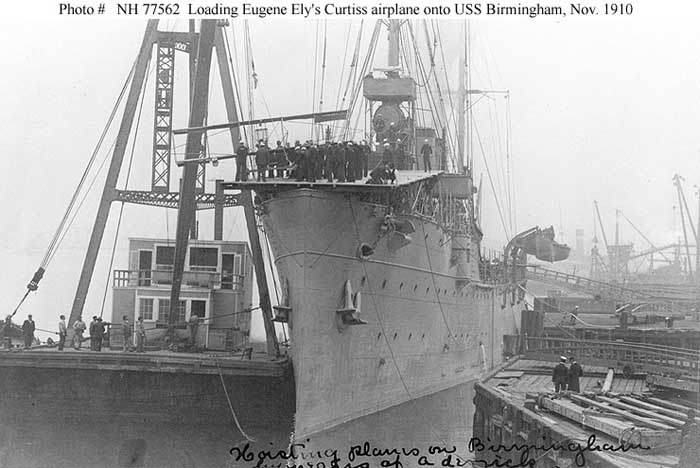|
|
Postcard #2 front and back.
________________________
Photos courtesy of Naval History & Heritage Command



1. Preparing to load Eugene Ely's airplane on USS Birmingham November 1910
2. Placing Ely's airplane on USS Birmingham November 1910
3. Placing Ely's airplane onto USS Birmingham November 1910
4. Eugene Ely's Custiss airplane on the take-off platform on USS Birmingham November 1910
5. USS Birmingham underway with Eugene Ely's airplane on board November 14, 1910
6. Eugene Ely, in a Custiss airplane, takes off from USS Birmingham November 14, 19107. Eugene Ely ready for return flight from USS Pennsylvania 18 Jan 1911
Eugene Ely, 1910
Dictionary of American Naval Fighting Ships
Courtesy of Naval History & Heritage Command
(Scout Cruiser No. 2: dp. 2,750 (n.); l. 423'3/4"; b. 47'3/4"; dr. 16'9½" (mean); s. 24.326 k. (tl.); cpl. 356; a. 2 5", 6 3", 2 3 pdrs., 2 21" tt.; cl. Chester)
The first Birmingham (Scout Cruiser No. 2) was laid down on 14 August 1905 at Quincy, Mass., by the Fore River Shipbuilding Co.; launched on 29 May 1907; sponsored by Miss Mary Campbell; and commissioned at the Boston Navy Yard on 11 April 1908, Comdr. Burns T. Walling in command.Assigned to the Atlantic Fleet, Birmingham completed trials and shakedown training and then began cruising along the eastern seaboard of the United States. That assignment continued until March of 1910 when she was selected to participate in a special mission. On 20 March, she stood out of Chesapeake Bay in company with her sister cruisers Chester (Scout Cruiser No. 1) and Salem (Scout Cruiser No. 3) bound for the west African republic of Liberia. The three warships carried members of a special commission appointed to investigate that country's financial and political difficulties. It was feared that European powers having neighboring colonial interests, notably Great Britain, were casting predatory eyes at Liberia. The visit of three of America's newest warships demonstrated dramatically the United States’ interest in the continued existence of Liberia as an independent republic. The scout cruiser concluded her voyage at Philadelphia on 31 May 1910.
Birmingham resumed normal operations along the eastern seaboard as a unit o£ the Atlantic Fleet. November of 1910 found her in Norfolk, Va., preparing to participate in a most notable experiment in the early history of naval aviation. A platform was constructed forward of her superstructure; and, on the morning of 14 November, she embarked one Curtiss biplane, the aviator Eugene B. Ely, and his support personnel. Also embarked were a group of naval officer observers headed by Capt. Washington Irving Chambers, a prime mover in early naval aviation. At 1130, Birmingham got underway and proceeded down the Elizabeth River to the Chesapeake Bay. After rainy, drizzly weather foiled several attempts at a take off, Ely's plane, falling almost as much as flying, left the cruiser's bow at 1517 that afternoon, in the first successful launch of an aircraft from a warship. The cruiser later sent her motorboat to pick up Ely at his landing place at Willoughby Spit. They then transferred to Roe (Torpedo Boat Destroyer No. 24) for the trip back to Norfolk. (See pictures below.)
Birmingham continued operations along the Atlantic coast into 1911. After a visit to Mobile, Ala., in February, she moved on to Haitian waters early in March to investigate conditions in that volatile republic. On the 22d, she headed to Guantanamo Bay, Cuba. The ship visited Panama late in May and early in June and, on 16 June, returned to Haiti. She completed that mission on 21 June and set a course for New England. She arrived in Boston on the 27th and was placed in reserve. Reactivated on 15 December 1911, Birmingham voyaged to Havana, Cuba, in March of 1912 to participate in ceremonies commemorating the sinking of Maine there in 1898. She returned to the United States at Hampton Roads on 19 March 1912 bearing the bodies of Maine crewmembers to be interred at the National Cemetery at Arlington, Va. She again went into reserve at Philadelphia on 20 April but returned to full commission on 18 May. The following day, the scout cruiser put to sea to participate in the International Ice Patrol that had been established in the wake of the tragic loss of life in the sinking of the British liner Titanic. She completed that assignment on 8 July and arrived back in Philadelphia on the 11th. She underwent repairs at the navy yard and then participated in a naval review at New York before joining the Atlantic Reserve Fleet at Philadelphia on 16 October 1912.
After almost a year of inactivity, Birmingham was recommissioned at Philadelphia on 1 October 1913 and, two days later, stood out down the Delaware River with members of the Panama-Pacific Exposition Commission. Over the following three months, the scout cruiser visited various Latin American ports in conjunction with the about-to-be-completed transisthmian canal. She returned from this round of goodwill calls on 26 December 1913. She remained in port at Philadelphia outfitting as a tender for and flagship of the Torpedo Flotilla. Birmingham stood out of Philadelphia on 2 February 1914 and headed for Guantanamo Bay, Cuba, where she arrived on the 8th and began her flagship duties. She remained in Cuban waters until late spring of 1914. Early in April, she visited Key West and Pensacola, Fla.
She was en route from Key West to Pensacola on 9 April when Mexican officials arrested some American sailors at Tampico sparking a crisis in relations between Mexico and the United States. The cruiser remained at Pensacola from 10 to 20 April taking on board an aviation unit consisting of one Curtiss floatplane and two Curtiss flying boats as well as Lt. John H. Towers, 1st Lt. Bernard L. Smith, USMC, Ens. Godfrey de Courcelles Chevalier, and 10 enlisted men. Birmingham sailed for Mexican waters on the 20th and arrived at Tampico two days later. She then disembarked the aviation unit which began operations from a shore base while Birmingham transferred refugees and conducted blockade operations. Her fliers did little at Tampico in contrast to their counterparts who had been shipped to Veracruz in Mississippi (Battleship No. 23). Birmingham joined her aviators in keeping an eye on German warships operating in the area. Both the cruiser and the aviation unit stood ready to make demonstrations should the Germans have attempted to intervene in any fashion.
Though the occupation of Veracruz lasted until November 1914, Birmingham remained on station at Tampico only until late in May when the Army relieved the Navy from occupation duty. She departed Tampico on the 23d, visited Veracruz on the 24th and 25th, and headed back to the United States on the 25th. She arrived at the Boston Navy Yard on 2 June and began a repair period that lasted for the remainder of 1914. On 31 December 1914, the scout cruiser resumed active duty with the Atlantic Fleet. Until the United States entered World War I on the side of the Allies early in 1917, Birmingham pursued a pattern of operations with annual winter maneuvers in Cuban waters followed by spring and summer evolutions off the northeastern coast of the United States.
Even for two months after America's entry into the global struggle on 6 April 1917, the warship continued her east coast operations, though on a war footing. Then, on 14 June, she put to sea from New York as flagship for Group 2 of the first American Expeditionary Force (AEF) sent to France. She returned to the United States from St. Nazaire, France, later that summer. At New York, she fitted out for distant service and, on 8 August, put to sea as flagship of the Commander, Patrol Force. The scout cruiser arrived at Gibraltar later that month and began service escorting convoys between Gibraltar and British and French ports. For the most part, that duty consisted of service outside the Mediterranean. However, after the armistice of 11 November 1918, she entered the Mediterranean for duty in support of the Armistice Commission. The warship made calls at ports in Italy and along the Dalmatian coast carrying out the naval terms of the armistice vis a vis the former Austro Hungarian Fleet.
Birmingham returned to the United States at Boston on 18 February 1919. After repairs at the Boston Navy Yard, she joined the Pacific Fleet in July 1919 as flagship for the Commander, Destroyer Squadrons, Pacific Fleet. From her base at San Diego, Calif., she ranged the western coasts of the United States and Mexico engaged in torpedo drills and various tests. On 17 July 1920, when the Navy adopted the alphanumeric system of hull classification and identification, she became CL 2. In May of 1922, she became flagship of the Special Service Squadron. Based at Balboa in the Canal Zone, she and the other ships of the squadron brought the steadying influence of American naval power to bear upon the politically volatile republics of Latin America. On 7 July 1923, Birmingham arrived back at Philadelphia. She was placed out of commission there on 1 December 1923. She remained in reserve at Philadelphia until 21 January 1930 when her name was struck from the Navy list. She was sold to the Boston Iron & Metal Co. for scrapping.
Raymond A. Mann6 February 2006